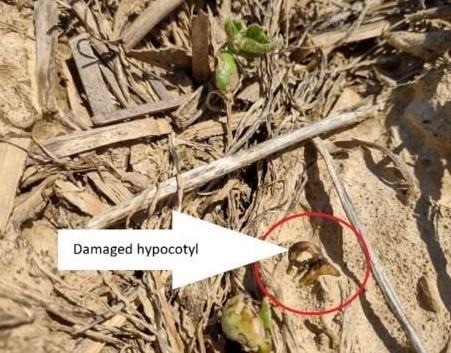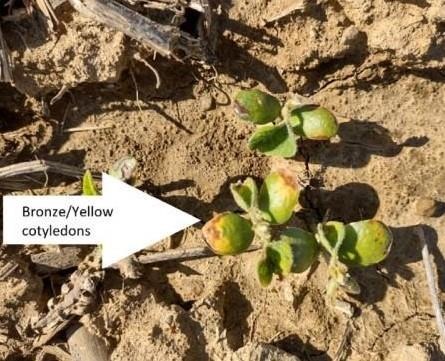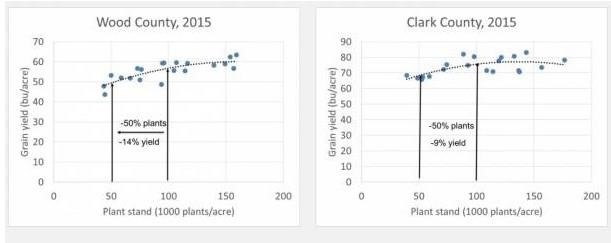By Laura Lindsey
Last week I checked-out our ultra-early soybean planting trials in South Charleston and Wooster (funded by Ohio Soybean Council). Both locations had soybeans planted on April 5/6 and April 28. At the Wooster location (northeastern OH), the soybeans planted on April 6 were emerging with the most advanced plants between the VE (cotyledons above the soil surface) and VC growth stage (unifoliate leaves unrolled and not touching). Soybeans planted on April 28 had not yet emerged at the Wooster location. In South Charleston (western OH), soybeans planted on April 6 were at the VC stage. The soybeans planted on April 28 were beginning to emerge.
Although planting conditions in early April were good, repeated frost and cool temperatures have slowed growth and damaged the soybean plants. There are several problems I observed last week:
1) Freeze-damaged hypocotyls. Hypocotyls are sensitive to cold temperatures at the “hook” stage as the hypocotyls pull the cotyledons up from the soil (Figure 1, top).
2) Soil crusting. Plants have been slow to emerge and seem to be struggling in some soils due to crusting. Soil crusting alone or in-combination with damaged hypocotyls have resulted in hypocotyls with missing cotyledons (Figure 1, middle).
3) Bronze/yellow cotyledons. Bronze/yellow cotyledons are an indication of frost damage (Figure 3, bottom). Here, the damage is mostly on the edges of the cotyledons with hew growth (unifoliates) a more normal green color, which indicates that the plant should begin to thrive as warm temperatures resume this week.



Figure 1. Damaged soybean plants likely caused by frost and soil crusting.
Before making re-plant decisions, it’s important to do a stand count. (See soybean stand count video here: https://www.youtube.com/watch?v=XHBL8SCmaKM). When soybeans are planted in May, a plant population of 100,000 to 120,000 is generally adequate for maximum yield. However, we do not recommend re-planting soybean unless the stand is <50,000 plants/acre. At low plant populations, soybean plants adjust by increasing the number of branches. For example, in Wood County in 2015, there was a 14% reduction in soybean yield when plant population was 50,000 plants/acre compared to 100,000 plants/acre (Figure 2). In the same year in Clark County, soybean yield was reduced by 9% when plant population was 50,000 plants/acre compared to 100,000 plants/acre.

Figure 2. Yield reduction when plant stand was reduced from 100,000 plants/acre to 50,000 plants/acre at two locations in Ohio in 2015.
Since the weather has been cool and soybean growth slow, I suggest planting your remaining corn and soybean fields first. Then, go back to your early-planted fields to assess damage and conduct a stand count. If the plant population from several areas within the field is <50,000 plants/acre, a re-plant is likely warranted. If the stand is 50,000 to 100,000 plants per acre, there will likely be a slight yield reduction. If the stand is >100,000 plants/acre yield should be maximized.
Source : osu.edu